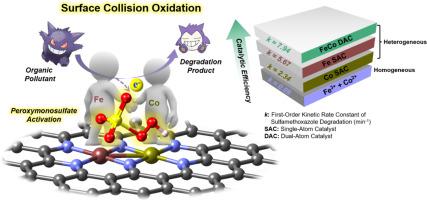Water Research ( IF 12.8 ) Pub Date : 2023-06-01 , DOI: 10.1016/j.watres.2023.120164 Changqing Zhu 1 , Fenxian Cun 1 , Zhongwei Fan 1 , Yu Nie 1 , Qing Du 1 , Fuqiang Liu 1 , Weiben Yang 2 , Aimin Li 1

|
Heterogeneous catalysts lag far behind their homogeneous counterparts in activating peroxymonosulfate (PMS) for water decontamination due to the low site intrinsic activity and sluggish mass transfer. The single-atom catalyst can bridge the gap between heterogeneous and homogeneous catalysts, but the difficulty to break scaling relations originating from the site monotony restricts further efficiency upgradation. Herein through modulating the crystallinity of NH2-UIO-66, a porous carbon support with ultrahigh surface area (1721.71 m2 g−1) is obtained to anchor the dual-atom FeCoN6 site, which exhibits superior turnover frequency over single-atom FeN4 and CoN4 sites (13.07 versus 9.97, 9.07 min−1). The as-synthesized composite thus outperforms the homogeneous catalytic system (Fe3++Co2+) for sulfamethoxazole (SMZ) degradation, and the catalyst-dose-normalized kinetic rate constant (99.26 L min−1 g−1) exceeds reported values by 1∼2 orders of magnitude. Moreover, only 20 mg of the catalyst can run a fluidized-bed reactor to realize continuous zero discharge of SMZ in multiple actual waters for up to 8.33 h. Unlike all reported reaction routes, the catalysis on the diatomic site follows a new surface collision oxidation path, i.e. the dispersed catalyst adsorbs PMS to generate surface-activated PMS with high potential, which collides with surrounding SMZ and directly seizes electron from it to induce pollutant oxidation. Theoretical calculation indicates that the enhanced activity of FeCoN6 site stems from the diatomic synergy, leading to stronger PMS adsorption, larger near-Fermi-level density of states and optimal global Gibbs free energy evolution. Overall, this work provides an effective strategy of constructing heterogeneous dual-atom catalyst/PMS process to achieve faster pollution control than homogeneous system, and sheds light on the interatomic synergetic mechanism for PMS activation.
中文翻译:

异相 Fe-Co 双原子催化剂在过氧单硫酸盐辅助水净化中的性能优于均相催化剂:新的表面碰撞氧化路径和双原子协同作用
由于位点固有活性低和传质缓慢,多相催化剂在激活过氧单硫酸盐 (PMS) 进行水净化方面远远落后于均相催化剂。单原子催化剂可以弥合多相和均相催化剂之间的差距,但由于位点单调而难以打破标度关系制约了效率的进一步提升。本文通过调节NH 2 -UIO-66 的结晶度,获得了具有超高表面积 (1721.71 m 2 g −1 ) 的多孔碳载体来锚定双原子 FeCoN 6位点,其显示出优于单原子的周转频率FeN 4和 CoN 4位点(13.07 对 9.97,9.07 分钟-1)。因此,合成后的复合材料在磺胺甲恶唑 (SMZ) 降解方面优于均相催化系统 (Fe 3+ +Co 2+ ),催化剂剂量归一化动力学速率常数 (99.26 L min -1 g -1) 超过报告值 1∼2 个数量级。此外,仅需20 mg催化剂即可运行流化床反应器,实现SMZ在多种实际水域中连续零排放长达8.33 h。与所有报道的反应路线不同,双原子位点上的催化遵循新的表面碰撞氧化路径,即分散的催化剂吸附PMS生成具有高电位的表面活化PMS,与周围的SMZ碰撞并直接从中夺取电子以诱导污染物氧化。理论计算表明FeCoN 6活性增强位点源于双原子协同作用,导致更强的 PMS 吸附、更大的近费米能级态密度和最佳全局吉布斯自由能演化。总的来说,这项工作提供了一种构建非均相双原子催化剂/PMS 过程以实现比均相系统更快的污染控制的有效策略,并阐明了 PMS 活化的原子间协同机制。


























 京公网安备 11010802027423号
京公网安备 11010802027423号